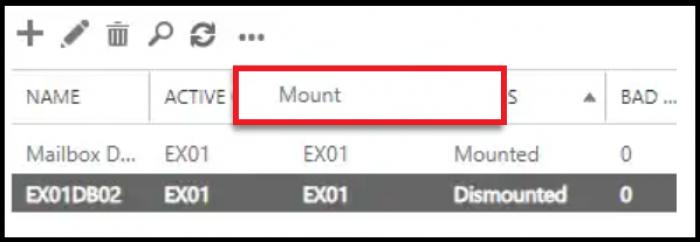Microsoft Exchange Server is a critical communication component for numerous organizations worldwide. It allows various crucial collaboration features, such as mailboxes, email, calendar, contacts, and task management. The server allows exchange of voluminous data within and outside organizations through a secure and trusted communication network. However, errors can still occur during the exchange of emails.
Specifically, the errors caused during database mounting can create big issues, requiring quick error resolution. In this blog, we will discuss database mounting and the errors caused during mounting, followed by their manual and automated resolution.
For automated rectification of the problem, an Exchange recovery tool such as Stellar Repair for Exchange would be feasible.
Database Mounting and the Possible Errors

Database mounting refers to bringing the Exchange database online, enabling users to access mailboxes and other essential information. Admins try several methods for this task, such as Exchange Admin Centre (EAC) or PowerShell Commands in the Exchange Management Shell (EMS). Irrespective of the method you use, several issues may stop the database from mounting on the Exchange server, such as:
- Exchange database in dirty shutdown state
- Insufficient server resources
- Hardware or software failure, leading to database corruption
- Exchange services stopped intentionally or abruptly
- Log files are corrupt or inaccessible
- Insufficient Permissions to access the Exchange database
- Error caused by time mismatch while database mounting
- An anti-virus software preventing access to log files
- Exchange server not updated recently or does not have the latest patches
Whatever the reason, prompt resolution of the issue is essential to keep the organization’s proceedings up and running. Here is the step-by-step guide to fix the Exchange Server database mounting errors. Hope it helps you resolve the issue at your end.
Resolving Database Mounting Errors
It is advisable to back up your Exchange database before you start troubleshooting the issue. After all, there has to be a contingency plan if your initial approach doesn’t work out. Once you create a backup of your Exchange Server Database, you are ready to be the troubleshooter. Here are a few must-have solutions in your checklist.
1. Examine Exchange Server Services
Navigate to the control panel to ensure that the Exchange server services are working fine. If you find any of them have stopped, restart them. This will probably fix the exchange database mounting error.
2. Ensure Enough Disk space
The database transaction logs will remain uncommitted under certain conditions.
- Your backup software is incompatible with your Exchange Server edition
- You have not backed up your server at all
In both these situations, your transaction logs will continue increasing, capturing all the space on your disk. If this happens, you will have less or no space to store the database and transaction logs. The solution is to keep a regular check on your disk space so that it never runs out of space.
You can purge uncommitted transaction logs by creating a complete server backup. If this is not possible, Windows Server Backup application to purge the transaction logs.
Diskshadow
add volume m: <This being the drive letter of the data drive>
begin backup
create
This will initiate the backup process. After its completion, type the following command:
End backup
This will set your database free from uncommitted transaction logs by committing and purging them.
3. Taking care of the Dirty Shutdown state
Often, you may leave the database transactions incomplete or complicate things with an improper shutdown. This results in a missing or an inconsistent log file, leading to a Dirty Shutdown state. Don’t panic, as the lines below will show you how to clean this dirt!
Here are the errors you will come across in the event of a Dirty Shutdown.
- JET_errLogFileCorrupt (Error -501): Indicates missing or corrupted transaction log files
- JET_errMissingLogFile: Indicates missing log files in the database you want to mount
- Database Mount Error (hr=0x80004005, ec=-501): Can occur due to missing or inconsistent log files
Should you also get any of these errors while mounting the Exchange Server database, here is how to fix them!
Check the database state: Initially, using eseutil /mh will show the Dirty Shutdown state
Commit the uncommitted log files: Try the EseUtil/r command for this EseUtil Soft Recovery process
Recheck the state: If the Dirty shutdown state persists, use the Eseutil/p command for hard recovery
The last option will remove corrupt or inconsistent log files from the database to get a Clean Shutdown state.
4. Backup Restoration
If the above methods do not work, you always have the option to restore the Exchange Server database from the recently created healthy backup. Nevertheless, this step may lead to loss of data from the time ranging from backup creation to the occurrence of a database mounting error. If it is still in the Dirty Shutdown state, proceed with soft recovery by using the EseUtil command.
5. Use an automated Exchange recovery tool
If none of your steps work fine to recover your database from the mounting error, an Exchange recovery tool can still work. Stellar Repair for Exchange is the software that you can use to fix the issue. This automated tool is the best for repairing corrupt and inconsistent database files existing in the Exchange database.
It effectively recovers the database in case of failed database mounting caused by Dirty Shutdown and related errors. You can use it to recover the mailboxes and their contents, such as emails, tasks, contacts, calendars, and public folders.
As obvious, the Stellar Repair for Exchange software is ideal to resolve the failed Mount Exchange Server Database mounting issues. Alongside, it performs several other tasks:
- Recovers EDB files with the risk of data loss
- Exports EDB files directly to Office 365 or Live Exchange Server
- Recovers the database in the case of a crashed Exchange Server
- Recovers corrupt Exchange Public Folders
Conclusion
Organizations depend largely on the Exchange Server Databases to continue their work. Any error in database mounting can therefore lead to undue chaos. Many issues can arise, such as Database Shutdown error, lack of server resources, no permission to access the database, hardware or software error, and so on.
To resolve the issue, you can try several methods, such as checking the Exchange database server or ensuring the availability of ample disk space for data storage. If the database enters the Dirty Shutdown state, you can try relevant solutions using the Eseutil recovery process to bring it back to the working state.
Creating a backup of the Exchange Database is equally necessary, as it helps to restore the database to its original state if the other solutions fail to deliver. In case all these methods are unable to resolve the Exchange server database mounting error, trying an automated solution would be the ultimate fix. A professional exchange recovery tool, such as Stellar Repair for Exchange, is the best option to consider in this regard.
Post Comment
Be the first to post comment!





